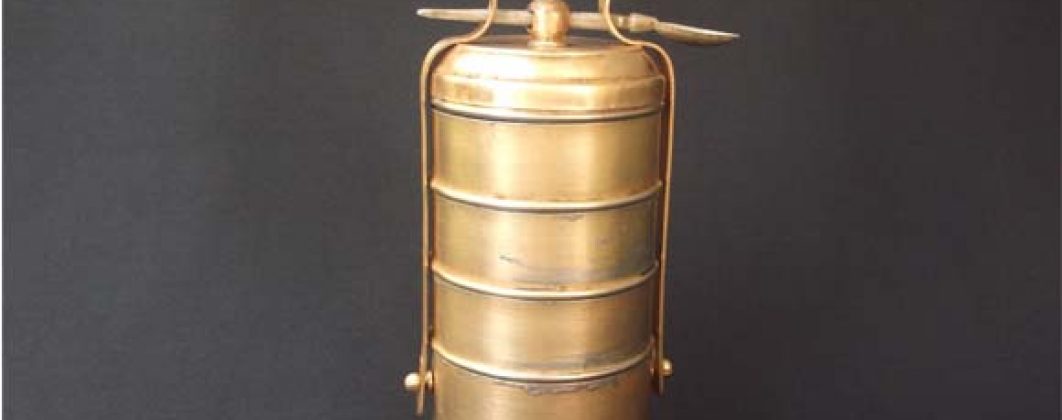

This vintage brass 5-tier tiffin box was used by me during my school days to carry lunch to my school. I was born in the year 1940. My grandfather who was a head master for the only elementary school we had in our village Someswaram, in the East Godavari District of Andhra Pradesh, India, had admitted me into the school when I was five years old after doing proper pooja and ceremonial Akharabhyasam (writing OM first time on the slate). I started going to school along with my grandfather Sri Yenugu Krishna Murthy carrying a palaka and balapam (stone slate and stone pencil) in a cotton bag. This was all my school kit. I graduated from 5th standard when I was 10 years old and that was the maximum education my school could offer. The nearest high school was 5 kilometres away and the only way to reach there was by a bicycle. Since I was considered as too young to go alone on a bicycle, my grandfather decided I should stay with my uncle Sri Rajupanthlu garu in the town Peddapuram.
I was admitted in the ULCM High School, Peddapuramin the 1st form (now equivalent of 6th standard) and I successfully completed my 3rd form when I was 13 years old. By then, I was considered eligible to ride a bicycle. So I was shifted back to our village Someswaram and got admitted in a high school in a village named Rayavaram about 5 kilometres from my village. I got a new cycle and a tiffin carrier with 5 boxes in the year 1953. I do not know if I got a brand new lunch box or an already old one by then. Let us consider that as new at that time. That brings us to the age of this 5-tier brass tiffin box set at 60 years old.



This 13 inches tall lunch carrier has an assembly of five containers- a large one with 3 inches height, three medium sized ones with 2 inches height and a one small one (5th one) with one inch height. All the round boxes are 4.5 inches wide (diameter). All the five containers are held tight by a brass strap frame resembling an inverted “U”shape that has a bent at the top. The two parallel sections have grooves that fit snugly into the knobs on the lower container. The upper most box tightly fits into the bent part of the “U”. The top part of the “U” is used as a handle to carry the tiffin carrier assembly. There is an aluminium spoon that holds the boxes and the frame together. The brass frame has two holes at the bent, and the top vessel lid has a knob with one hole. When the frame is pushed on to the five container assembly, the two holes in the frame and the hole at the top box lid come in a single straight line and the aluminium spoon is inserted through the 3 holes. That seals the assembly tight.
The lunch carrier has a stamping on the top vessel cover reading as ” 41/2“meaning there are four and half containers in the assembly.The top box which is of 1 inch height is considered as half box. There is also another stamping giving the patent details reading as “Patent1937 HK22729”. This reveals that this design was patented in the year 1937. I do not know who the manufacturer is but with the help of patent number maybe we can find the manufacturer. All the vessels are coated with tin coating, locally known as tagarampoota. This coating is given to prevent the contact of the food with brass metal since brass reacts chemically with certain types of food materials, particularly Tamarind juice, which is profusely used in Andhra food preparations, and also with lime juice.That is precisely the reason as to why an Aluminium spoon is used instead of a brass spoon.The spoon is used for locking purpose and also as a spoon for serving and eating purpose.You cannot eat food with brass spoon for the reason of chemical reaction. Hence aluminium spoon is used which serves both the purpose.



I used to start from home at 9 a.m. every day to school and my mother used to keep my lunch carrier, which she used to call it dabba, ready by the same time packed with hot food for my mid-day meal. She used to pack rice in the big dabba at the bottom, the second one with the pulusu or pappu, the third one with vegetable curry, the fourth one with curd and the top one with pickle. The pickle will be either Aavakaya with badda ( mango slice) or Maagaya with juicy tenka (mango seed). I used to keep the hot brass tiffin box into a cotton bag with handles and hang the bag on the left side of the handle bar of the cycle. My school books were pushed into another similar bag and it was hung on the right side of the handlebar. This was how my journey to school started. If there was an item of interest, it was the carrier. My mind would always be on the carrier instead of on the class subject and I would wait impatiently for the lunch time bell. The children of our village used to sit together and eat our lunch and most of the times we used to share our lunch. Our school used to be at the far end of the village amidst paddy fields.There used to be small canals (bodikalva) to irrigate the paddy fields. We would sit on the banks of these canals under a mango tree and eat lunch with a picnic atmosphere. After that we would wash our tiffin carrier in the canals, reassemble them and put it back in the cotton bag.
I was using this vintage brass lunch carrier for three years during my studies for 4th,5th forms and SSLC (Secondary School Leaving Certificate) which is equivalent to present day 10th. After my SSLC, I had gone to Kakinada to study my Intermediate in PR College. Thus, my cycle journey and my dear lunchbox carrier were given rest. While my cycle was disposed, I retained the brass lunch carrier, my companion for 3 years. It is now an integral part of my antiques collection. This fabulous 5-tier tiffin box is my goddess Annapoorna which fed me for three years in my life.
I do hope you enjoyed reading this posting on Vintage Tiffin Carrier as much as I did writing it. I love to receive your comments.
UPDATE – Jun 28, 2017
Take a look at the video that we’ve recently uploaded. Hope you like it.

Copyright © 2021 YK Antiques Home Museum
8 Responses
I WANT TO BUY IT.WHERE IS THIS
i have always admiered antique vessels. i have few of my own (very few)… i have fallen in love with your pieces. they r an amazing collection. Everytime I spot one exqusit piece, they turn out to be too expensive… am glad you have managed to collect so many and have given wonderful descripton of evey piece… hope to someday own a colletion like yours… if by any chance (which i know would be slim) your willing to dispose an item, please keep me in mind. Once again, what a lovely collection and an equally lovely description.
opps… just incase for that very slim chance… my email id – rmy.rjn@gmail.com
Hello Ramya Rajan Sir,
We are the manufacturer of such kind Entique tiffin box, which gives you a very Entique look, if you interested in having a look we can share the sample image to you.
Please let us know if you interested.
please do send me your catalogue,
kapil
Thank you! For sharing your story!
I have a 2 stack and had some questions about it that helped me understand it better
Like why there is a hole at top ( it’s is missing the spoon/fastener you had talked about) I have tapped numbers on mine. Ur no patent. I will take better care of it and hope to someday find out where it came from
The top says janta tiffin carrier India
(Everyday ware is my guess ) again thank you!
Thank you for reading the article and writing to us. Nice to know you have a two stack tiffin carrier. The hole at the top is meant for inserting the spoon which also serves as a lock. If the spoon is missing, you can put a wooden spoon across to secure the carrier. You can later replace it with an old spoon when you manage to acquire one.
The tapped numbers on your tiffin carrier can reveal some story about its manufacturer or time period or place. If you can share the picture of the numbers, we might be able to get some information. You can write to us at ykantiques@gmail.com
‘Janta’ means the general public or a representation of the average middle-class person in India. The everyday ware guess is correct.
Hello Kapil,
This item is a collection for exhibition in YK Antiques Home Museum. It is not for sale.